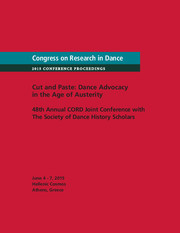No CrossRef data available.
Article contents
CORD Awards Panel 2014: “Celebrating the Scholarship of Deidre Sklar—Can Sklar-Lore Be Brought to Its Senses?”
Published online by Cambridge University Press: 17 September 2015
Extract
I am both honored and humbled to comment about the impact of Deidre Sklar's work on my research and teaching. More than anything, I consider Dr. Deidre Sklar a kind of dance ethnology big sister. I first learned of her when I was a student at the University of California Los Angeles's (UCLA) internationally recognized former dance ethnology program, where Deidre had attended nearly a decade before me. Those of us who went through this unique and intensive program often felt as if we knew each other, even if we had never met. The program was a kind of nation of black sheep; we were kindred spirits in our love and participation of different kinds of global movement practices at a time when ballet and modern dance were exclusively the norm. Also, our mentors, Allegra Fuller Snyder and Elsie Ivancich Dunin, made it a point to share the distinctive investigations of our predecessors. So I think it was in this context that I first learned of Deidre. Over the years, I recall short but poignant conversations with her which left me pondering for months afterwards. Some of our fleeting encounters occurred in the bustling dark hallway of an American Anthropology Association (AAA) conference hotel in San Francisco, taking in the arid air outside of the Cross-Cultural Dance Resources (CCDR) meeting space in Flagstaff, or smelling fire-baked tortillas and hearing cocoon rattles as we stood observing the awe-inspiring Yaqui Easter ceremony in Tucson. As a newbie dance ethnologist in those years, I found Deidre's strong, direct ways, her laser sharp insights, thought provoking questions, and bold comments somewhat intimidating—all features I have grown to admire and value now.
- Type
- Research Article
- Information
- Copyright
- Copyright © Miriam Phillips 2015


